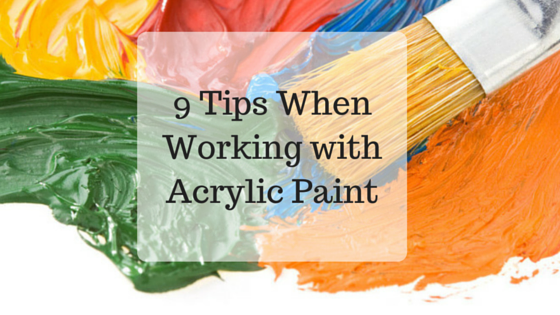If you are looking to use acrylic paint during your art classes or whenever you have some free time to paint, check out these nine handy tips to make the best out of your chosen type of paint.
Keep a cup of water next to your palette
Have an atomizer next to your paint palette
In any case, use a retarder
Use basic supplies for a variety of application techniques
Dry brushing is applying undiluted acrylic paint on canvas. This is great for applying texture and movement to your painting.
Washing is the opposite of dry brushing where you dilute acrylic paint with enough water before applying on your canvas. Washing is fantastic for when you want translucent washes on your painting surface.
Stippling is making tiny paint dots to create an illusion of texture on your canvas. You can use stippling if you want to create subtle variations in color.
Flicking is using a wet paint brush, dipping it in paint and applying it on your canvas to create an uneven splatter. Use this technique when creating abstract art. It's also a great way to add texture to your work.
Control the amount of water you use
For finer details, use a palette knife
How to use this? Just scrape a bit of paint using your palette knife and apply it on your canvas. Imagine you're applying icing on a cake and you'll get the motion pretty quickly. Apply this technique when doing flowers or leaves on your next artwork.
When layering, always start from the bottom up
Start by painting massive blocks of colors or washes on the base of your canvas and then add more details and refinements as you add more layers. While layering is a technique most commonly applied when painting self-portraits, it applies to any subject matter you wish to paint.
Always plan your artwork before getting started
Trace your image on your canvas and separate each color or tone in different shapes like a paint-by-numbers piece. This will guide you what color of acrylic paint to prepare first and apply on your canvas. This is a great step for beginners and can easily be employed whether you are working with monochromatic shades or a variety of colors.
Be creative with your color mixing techniques
Partially-mixed colors - instead of fully combining two colors, just give it a brief mix with your brush or palette knife. Use these partially mixed combinations when painting. You can create unique tones of the color you wish to use and get a fantastic mingling of these shades on your canvas.
A family of colors - Creating your own tones to work with for your painting will allow you to create subtle differences in your artwork. You can create artistic variances of skin tones for your canvas and when you create these pre-mixed tones ahead of time, this can definitely help you streamline the process.
Make sure to have fun!
Learn the beautiful art ofacrylic painting here at Art Smart!
Our art studios are located in Marikina or 500 Shaw Zentrum. Check out our rates and schedules of art classes and get in touch with Teacher Aubrey directly for inquiries at 0917-8784766. Learn more about the Art Smart Program too at this page.

 RSS Feed
RSS Feed
